-
DisplacementThe distance and direction of a particle from the equilibrium position
-
AmplitudeMaximum displacement of a vibrating particle
-
WavelengthShortest distance between two particles in phase
-
FrequencyNumber of wave cycles ocurring each second
-
Wave speedDistance travelled by a wave each second
-
phase differencemeasured in degrees or radians, the amount by which one wave lags behind another wave
-
path differencemeasured in meters, the difference in the lengths of two waves
-
ProgressiveWaves whose oscillations travel and tansfer energy
-
Transverse wavesWaves whose oscillations are perpendicular to the direction of propogation of energy e.g. electromagnetic waves
-
Longitudinal wavesWaves whose oscillations are parallel to the direction of propogation of energy They consist of compressions and rarefractions e.g. sound waves
-
Which type of wave can only be polarised?transverse waves
-
PolarisationAll the waves are oscillating in the same plane The discovery of polarised light helped prove that light was a transverse wave
-
Polarisation usesPolarisation can be used in things such as polaroid sunglasses to reduce glare or in a camera to enhance the image
-
Radio signals (polarisation)TV and radio signals are polarised by the diretion of the rods on the transmitting aerial. To receive these signals well, you must ensure the receiving aerial and the waves are in the same plane.
-
SuperpositionThe point where waves meet is called superposition. The total displacement at apoint is equal to the sum of the individua displacements at that point
-
Constructive interferenceConstructive interference occurr when two superposing waves are in phase with each other
-
Destructive interferenceTwo superposing waves will destructively interfere when they are in antiphase with each other
-
How can interference be explained in terms of peaks and troughs?When the waves are in phase two peaks/troughs will constructively interfere resultin in a 'double' peak/trough When the wves are in antiphase a pek will meet a trough and destructiveely interfere, when they will cancel each other out and produce a minimum point
-
Stationary waveA stationary wave is a wave that stores energy instead of transferring from one point to nother
-
How is a stationary wave formed on a string?The string must be fixed at both ends. A wave is generated at one end of the string and travels down it At the other end, this wave is reflected and travels back in the opposite direction The frequency of the wave generation and the lsngth of the string are such that the next wave generated meets this reflected wave and undergoes superposition At places where the two waves in phase, they undergo constructive interference and form a maximum point known as an antinode At places where the two waves are in antiphase, they undergo destructive interference and form a minimum point known as a node
-
Fundamental frequency equation

-
How to increase the pitch of a stationary wave?raising the tension or shortening the length
-
Young's doube slit experimentWhen two double slits are illuminated, the two slits act as coherent wave sources. The light diffracts as the slits and the two waves superpose, forming an interference pattern, this is because a combination of constructive and destructive interference occurs.
-
double slit formula
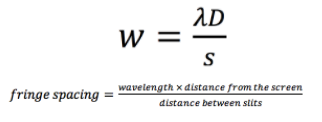
-
Evidence for the wave nature of EM radiationdiffraction and interference are purely wave properties, so this experiment showed that EM radiation has wave properties
-
DiffractionDiffraction is the spreading out of the waves when they pass through a gap or over an edge.
-
What does diffraction depend on?Diffraction depends on the gap width and the wavelngth of the wave. If the gap is: A lot bigger than the wavelength, the diffraction is unnoticeable A bit wider than the wavelngth, the diffraction is noticeable The same size as the wavelength, the diffraction is most noticeable Smaller than the wavelength, most of the waves are reflected
-
Consequence of diffraction when light is shone through a diffraction gratingMonochromatic light will display a diffraction pattern White light creates a spectra of colours
-
Intensitya measure of the power delivered per unit area
-
What does increasing/decreasing the slit width do?Increasing the slit width creates an intense but narrow central maximum Decreasing the slit width creates a wider and less intense central maximum
-
Single slit diffraction
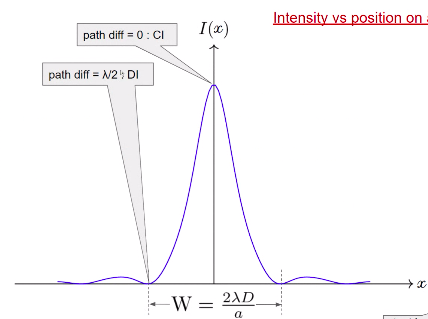 Shine a monochromatic light at a single narrow slitA diffraction pattern, of bright fringes separated by dark fringes, is see on a screen placed behind the slit
Shine a monochromatic light at a single narrow slitA diffraction pattern, of bright fringes separated by dark fringes, is see on a screen placed behind the slit -
Intensity vs position on a screen for single slitWidth of the central maximum is twice the other maximaCentral maximum is zero path difference 1st minimum is 𝛌/2 path differenceCentral maximum is much brighter than outer onesThe intensity of the fringes decreases from the central fringeThe bright lines are called ‘fringes’, they are equally spaced apartEach fringe is an order of interferenceFringe width = fringe separation
-
double slit
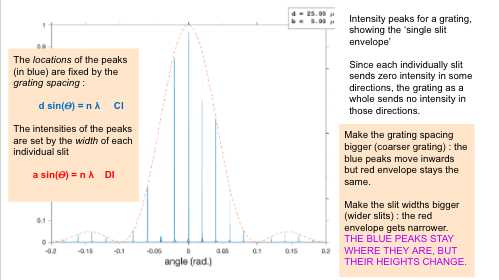
-
single slit effect on the douvble slit
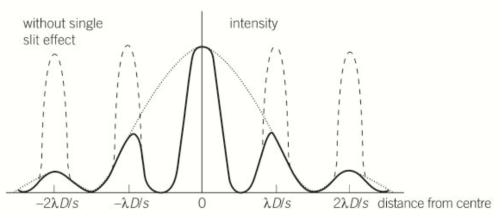 Systematic variation in intensities of peaks in double slit and gratingWhich may result in the complete suppression of some orders of interference, depending on the slit width to slit separation rationThis is called single slit pattern modulating (regulating) the multiple-slit pattern
Systematic variation in intensities of peaks in double slit and gratingWhich may result in the complete suppression of some orders of interference, depending on the slit width to slit separation rationThis is called single slit pattern modulating (regulating) the multiple-slit pattern -
The appearance of the diffraction of white light through a single slit onto a screenWhite light is made up of different wavelengths of visible light and so the different wavelengths of light are all diffracted by different amounts so you get a spectrum of colour in the diffraction patternThe diffraction pattern for white light has a central white maximum with alternating bright fringes which are spectra, violet is closest to the central maximum and red furthest away (shorter wavelength to longer wavelength)White central maximum is due to the fact that every wavelength will have a 0 path difference and all interfere hereGeneral reduction in saturation
-
diffraction gratinga slide containing many (thousands) of closely spaced slits in an otherwise-opaque screenThe separation of the slits, distance between adjacent ones, are known as grating spacing and is a few wavelengths apart
-
why is the width of the aperture of a diffraction gratying one wavelengthThe width of each slit is a wavelength apart so as to diffract the light as much s possible
-
Why are there great areas of zero intensity diffraction grating
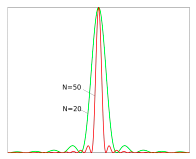 Due to the fact that there are so many light sources interfering with each other there are great areas of zero intensity ( destructive interference)
Due to the fact that there are so many light sources interfering with each other there are great areas of zero intensity ( destructive interference) -
why when monochromatic light is passed through a diffraction grating the interference pattern is much sharper and brighter than it would be after being passed through a double slit?Due to there being more rays of light reinforcing the pattern, and so measurements of slit widths are much more accurate as they are easier to takeAs seen in the graph the intensity of the interference pattern increases with the number of slitsThe constructive interference peaks become narrower as the number of slits increases and the destructive interference ‘increases’ with intensity - young’s slits hyper extremes
-
The difference between two slits (young’s) and many slits (grating):Sharpness of linesBrightness of linesNot shown in diagramsLarger angle of deviation of a given order of interferenceBut only because the slit separation is invariably smaller for a gratingPoints of constructive interference is more spreadFringes are ‘equally’ wide in double slit in comparison to single slitIn single slit central maximum in double the width than the ther fingesAt any angle that is not the critical angle you get a near perfect destructive interference
-
The derivation of d x sinθ = n x λ :
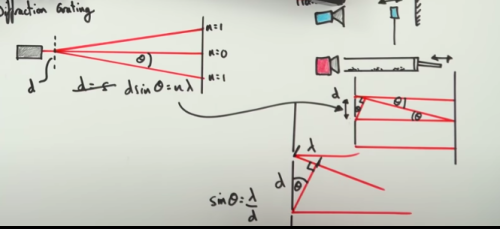 The path difference between two adjacent rays of light is one wavelength, and the angle between the normal to the grating and the ray of light is θA right angle is formed with the lengths d and λBy using trigonometry for the first maximum sin θ = λ/dThe other maxima occur when the path difference between the two rays of light is nλ, where n is an integer, and so we can generalise the equation by replacing λ with nλ to get : d x sinθ = n x λ
The path difference between two adjacent rays of light is one wavelength, and the angle between the normal to the grating and the ray of light is θA right angle is formed with the lengths d and λBy using trigonometry for the first maximum sin θ = λ/dThe other maxima occur when the path difference between the two rays of light is nλ, where n is an integer, and so we can generalise the equation by replacing λ with nλ to get : d x sinθ = n x λ

